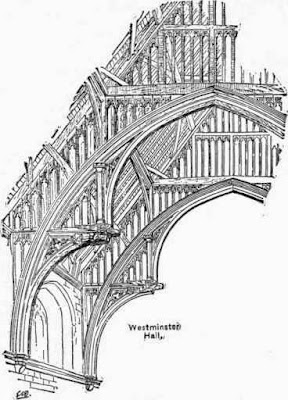I would never have become a custom furniture builder had it not been for my time living in the UK. My mind was open, I was surrounded by thousands of years of history, and I was exposed to rich palate of art, design and architecture. And although there were some disappointments (Stonehenge, Marmite, Stoke-on-Trent), there were several things that just blew me away -- The Devonshire Hunting Tapestries in the V&A, Supermarine Spitfires . . . and the Hammer-Beams in Westminster Hall. Built in 1393, this ingenious system of timbers changed the architectural world forever, and made a statement about where England ranked in the medieval world.
This image has been bouncing around my head for awhile, and as I start to apply this style to a piece I'm working on, it made me think a bit about how I go about designing a new piece of furniture. I'd be interested in hearing how you go about this process as well.
For me, I think I start by asking myself a series of questions -- not always in this order -- and not usually in quite such an organized way.
What is the function of the piece? Is it a table, a chair or a desk. Regardless of how creative I want to be, there are conventions that I feel comfortable working within. If I stray too far outside the norm, I move from working furniture, to studio furniture, to contemporary art -- and I don't have the design chops to hang with that crowd. (In this case, it is a low table that can be shipped, flat, and may become part of a "line" of furniture that I debut in September.)
For whom am I making this piece? Is it a custom one-off, or will I want to replicate it. Is it built on spec, for a specific individual, or for myself. This will determine whether I deviate from standard dimensions, keep a build diary, or alter my method of work for replication. (I hope to build again, and it should be robust and appeal to people who prefer arts and crafts style custom furniture.)
 |
| I start with a big piece of paper, a T-square, a ruler, and some idea of what I want to build. This is the base of the table. |
What is the major design element? Whether it stays within a particular genre, or pushes forward a single visual element, it needs (for me) to have a "plot" to it. "This is my interpretation of a Morris chair", or "I'm going for a Usonian credenza look," is enough. I like designs that are fairly singular and can be articulated. (English arts and crafts, Gothic/Gothick, Cotswold's style.)
What kind joinery will be used, and is that joinery part of the design (dovetails) or merely functional? This generally raises other questions about cross grain situations and mechanical fasteners. (modified mortise and tenon, both for function and show, and the design provides some efficiencies.)
 |
| The bending strip allows me to play with the curve using nails to adjust and hold the bend in place. |
Can I visualize the order of operation? I always get into trouble if I don't thickness all relevant stock at the same time. Also, if there is a fussy machine set-up or cobbled together jig, I want to do it once and move on. (It's pretty straight-forward.)
 |
| Once I like the bend, I create a 2 3/4" radius circle out of fibreboard that allows me to trace a line 2 3/4" away from the curve to create a design element. |
Do I need to create a drawing (probably), make some templates (usually) or build a mock-up? (not that often) (Absolutely jigs for the curved bits, and a drawing from which to make templates.)
What wood will I use? Which prompts the question, "How will I finish this piece?" If the wood is particularly pricey, I may actually opt to do the mock-up. (Oak, with QS Oak or Pippy oak on the top.)
What will be the biggest challenge? There is usually one part of the gig that wakes you up in the middle of the night. If I'm in game-shape, and in my stride I may start with this to ensure that I can do it properly -- then everything is downhill sledding. Or, I may want to refresh those skills on another part of the project and "work myself into shape" before I tackle the line of dovetails or that turned leg. (Bread board top. It's not too difficult, just time consuming.)
Is this piece "The One"? Every artisan that I admire must have made his or her first signature piece without knowing that it would define their career. Can I see the potential for something important in the midst of the inevitable frustrations of a first build. (Who knows, but I do think there is a theme upon which I can expand.)
 |
| A sneak preview of the bottom portion of the table leg. This is the only part of the design that I feel is complete. |
Cheers! - And let me know about your design process!



Nice Blog. Thanks for sharing.
ReplyDeleteRegards,
Jack
SEO Analyst
SEO Services Chennai| SEO Chennai
Viewing old architecture can get my creative juices flowing. For one project many years ago I searched for Gothic buildings. Good post.
ReplyDeleteThanks, Guys.
ReplyDeletethanks for your sharing gan ??
ReplyDelete